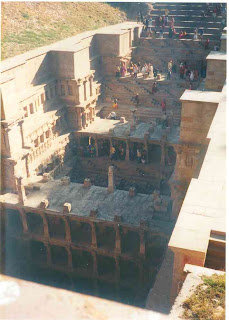GREETINGS
Step Wells - of Gujarat & Rajasthan
I had visited Somnath temple on a Teerth Yatra in Jan 2009 and en route stopped at Rani ki Vav-- a Stepwell --
a magnificent construction.. Some pics and
details
FROM Smt. Anuradha Philar - a family friend,
wrote to me giving details
"Water in the architecture of India could
be found since the earliest times and had played an important role in the
culture. Stepwells were first used as an art form by the Hindus and then
popularized under Muslim rule.
Stepwell construction is known to have gone on from at least 600 AD in the south western region of Gujarat, India. The practical idea even spread north to the state of Rajasthan, along the western border of India where several thousands of these wells were built.
Stepwell construction is known to have gone on from at least 600 AD in the south western region of Gujarat, India. The practical idea even spread north to the state of Rajasthan, along the western border of India where several thousands of these wells were built.
The construction of these stepwells hit
its peak from the 11th to 16th century. Most existing stepwells date from the
last 800 years. There are suggestions that they may have originated much
earlier, and there are some suggestions that precursors to them can be seen in
the Indus Valley civilisation.
The first rock-cut step wells in India
date from 200-400 AD.Subsequently, the wells at Dhank (550-625 AD) and
construction of stepped ponds at Bhinmal (850-950 AD) takes place.The city of
Mohenjo-daro has wells which may be the predecessors of the step well; as many
as 700 wells have been discovered in just one section of the city leading
scholars to believe that 'cylindrical brick lined wells' were invented by the
people of the Indus Valley Civilisation.One of the earliest existing stepwells
was built in the 11th century in Gujarat and is known as the Mata Bhavani's vav.
A long flight of steps leads to the water below a sequence of multi-story open
pavilions positioned along the east/west axis. The elaborate ornamentation of
the columns, brackets and beams are a prime example of standard of civil works
then
The importance of water to the locations
in which they were found have been realized in the past decade now that many
communities in the area are scarcity of rain and water. The construction of
these wells encouraged the incorporation of water into the culture where they
were popular. These stepwells were even proven to be well built after
withstanding earthquakes in the range of 7.6 on the Richter scale.




No comments:
Post a Comment